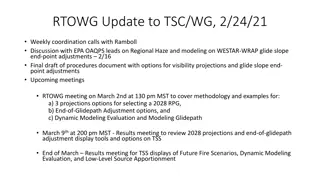
System Modeling for Homelessness Solutions
Explore the concept of system modeling for addressing homelessness, including the process, data requirements, tools available, and real-life examples. Discover how communities can develop optimal systems to prevent and end homelessness effectively.
Download Presentation

Please find below an Image/Link to download the presentation.
The content on the website is provided AS IS for your information and personal use only. It may not be sold, licensed, or shared on other websites without obtaining consent from the author. If you encounter any issues during the download, it is possible that the publisher has removed the file from their server.
You are allowed to download the files provided on this website for personal or commercial use, subject to the condition that they are used lawfully. All files are the property of their respective owners.
The content on the website is provided AS IS for your information and personal use only. It may not be sold, licensed, or shared on other websites without obtaining consent from the author.
E N D
Presentation Transcript
What is your experience with system modeling? 1. No experience, not sure what system modeling is 2. Familiar with the concept of system modeling, but haven t had an opportunity to do it yet 3. Been there, done that, have the t shirt!
Learning Objectives 1. Identify and discuss the system modeling process 2. Understand the data and resources necessary to complete the system modeling process 3. PreviewHUD s new tool to assist with system modeling, called the SPIST
Acronyms SPIST: System Performance Improvement Strategies Tool; a web-based system modeling tool in development for CoCs LSA: Longitudinal System Analysis; a HUD report, produced from a CoC s HMIS and submitted via HDX 2.0
System Modeling Data driven planning process, where a community develops a model of the optimal system to prevent and end homelessness in their CoC Ideally, this process is iterative and is inclusive of key stakeholders (important to think of this as much more than a data project )
Example of System Modeling: Washington, D.C. (Homeward DC) Led to increased funding from a broad group of stakeholders $23 million in new investments $100 million for affordable and supportive housing Information on report is available at https://ich.dc.gov
Thinking of an Optimal System If you could start with a blank slate, what would your optimal system look like? How would you serve people differently? What inventory would your optimal system have? How much would it cost to have an optimal system to meet the needs of every person experiencing homelessness each year?
Vision of an Optimal System A homeless crisis response system that has enough housing and services of the right type to: Prevent homelessness when possible Rapidly and successfully end homelessness when it occurs so people exit to housing and remain housed with the least amount of assistance needed A community with this kind of system would be community where homelessness is rare, brief and non-recurring
Guiding Principles Person-centered Housing First Permanent housing focused Side doors to projects and system closed Coordinated entry used to: determine best intervention for each individual or family fill all project vacancies
What is System Modeling? Tool to assist CoCs to develop a vision of the set of interventions that would more effectively serve everyone who becomes homeless Process to help CoCs understand how different levers such as length of stay in projects and in the system, targeting of programs and change in operations can affect performance Model of an optimized system can help communities estimate the resources needed to meet the needs of homeless households and develop a plan for the transition to an optimized system
Step 2: Understand Current System Estimate annual number of households experiencing homelessness Review system utilization data: Length of stay in projects Combination of projects used as a pathway to permanent housing Exits to permanent housing from different program types LSA data will be HUGELY helpful with the items listed above, as all are included in the LSA
Step 3: Develop Service Pathways and Length of Stay Develop pathways through the system that people are most likely to use Ex. Shelter to RRH to PH exit Estimate what percentage of people will need each type of pathway Ex. Coordinated entry data shows that 40% of families need rapid re-housing assistance Estimate how long people will stay at each program in each pathway Ex. Shelter stay 1 month then RRH 6 months then exit to PH
Calculating Inventory Estimate length of stay in each program in each service pathway Use service pathways and length of stay estimates to calculate how many units or subsidy slots are needed at a point in time Example 10 families enter shelter each month 20% need shelter only for 2 weeks 10% go to TH after 1 month in shelter 50% go to RRH after 1 month in shelter 20% go to PSH after 2 months in shelter 1 bed 5 beds 4 beds 11 beds 1 bed
Families Projected System Utilization (Av Months of Asst in ea Prog Type) Overall Strategy (%) Detail Strategy (%) Rapid Re- Housing Intensive Permanent Supportive Housing Service Pathways Emergency Shelter Transitional Housing Rapid Re- Housing Shelter Diversion TAH Strategies for People Presenting Each Month Shelter Diversion Emergency Shelter Only TH only (not through CA or ES) TH (through CA or via ES) TH w RRH at Exit RRH (one-time asst) RRH (med-term asst) RRH (med-term asst) w TAH at Exit RRH Intensive PSH (via ES) TOTAL 5% 3% 5% 3% 0% 10% 10% 3% 40% 10% 10% 9% 100% 4 1 20% 1 2 2 2 2 2 2 9 9 9 1 9 9 63% 1 18 1 9% 100%
Step 4: Modeling the Inventory to Meet Annual Need Proposed System for Fam (Units) Program Types - FAMILIES (Pt-in-time Unit Count) Shelter Diversion Emergency Shelter Transitional Housing Rapid Re-Housing Rapid Re-Housing Intensive Permanent Supportive Housing Targeted Affordable Housing TOTAL 24 215 220 664 220 132 147 1,622 Subpopulations Hshlds Expected to Present Annually # of Fam 1,466 Av LOTH 9 Av Asst 22
Step 5: Develop Cost Estimates Survey current projects of each program type to gather comprehensive cost data Develop estimated costs for each program type using program descriptions in program models document
Step 6: Transition to an Optimal System Current System (Revised 2014 HIC) Inventory Coordinated Assessment Shelter Diversion Emergency Shelter Transitional Housing Program Types - FAMILIES (Pt-in-time Unit Count) Difference (2014 to 2020) 2016 2017 2018 2019 2020 Inventory Inventory Inventory Inventory 0 24 677 294 847 220 897 147 3,106 24 565 294 664 220 1,029 287 3,083 24 454 220 664 220 1,161 419 3,162 24 343 220 664 220 1,293 545 3,309 24 215 220 664 220 1,425 665 3,433 24 (700) (200) (18) 220 660 665 651 915 420 682 0 765 0 2,782 Rapid Re-Housing Rapid Re-Housing Intensive Permanent Supportive Housing Targeted Affordable Housing TOTAL
Tools and Resources for System Modeling
Leveraging Existing Reports for System Modeling LSA includes information needed in Steps 2 and 3, regarding length of time homeless and pathways
Leveraging Existing Reports for System Modeling Data included in the LSA that is helpful for determining pathways includes: Households who used PSH only Households who used ES/SH + PSH only Households who used ES/SH+RRH+PSH only Households who used RRH+PSH only Households with any other project combinations not specified above
Upcoming Resource HUD is working on the development of the SPIST, the System Performance Improvement Strategies Tool Will be a Performance Module, to help understand the current system (including pathways) and will be built into HDX 2.0 (timing of module is TBD) Will be two other modules (still in development), that will also help with system modeling Once released, this web based tool will be available for use in the System Modeling process that we went through today






















